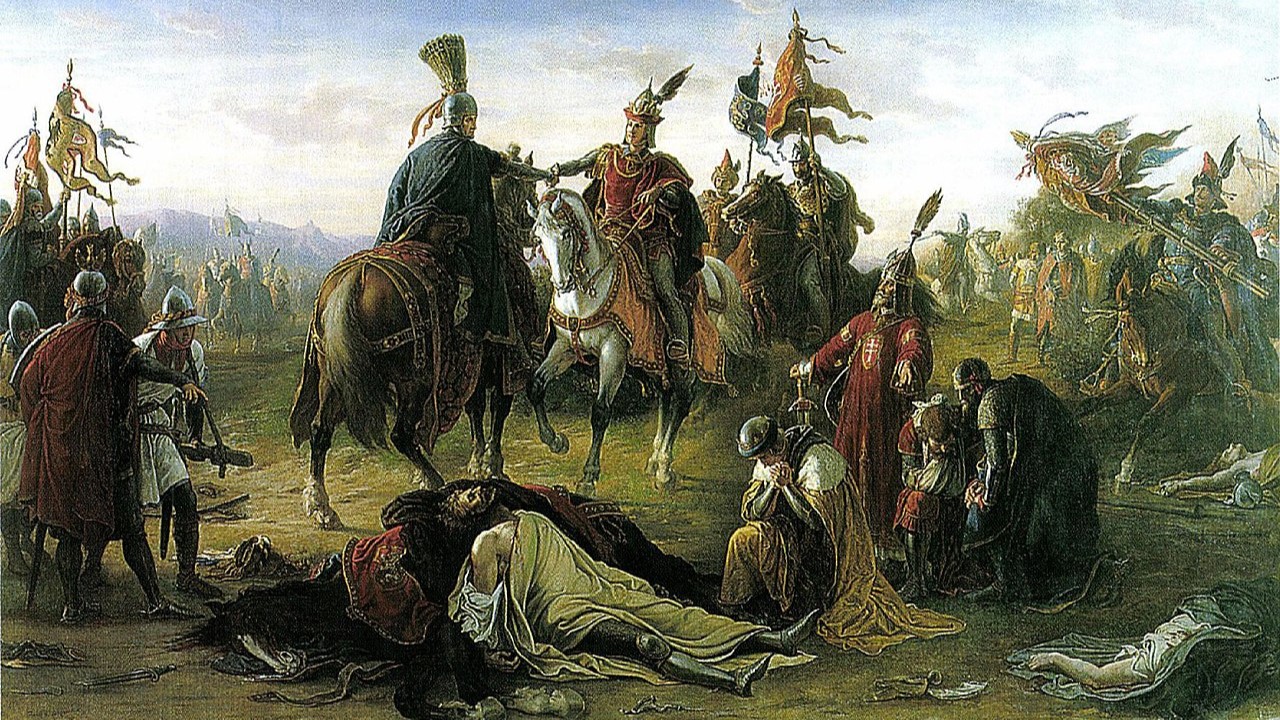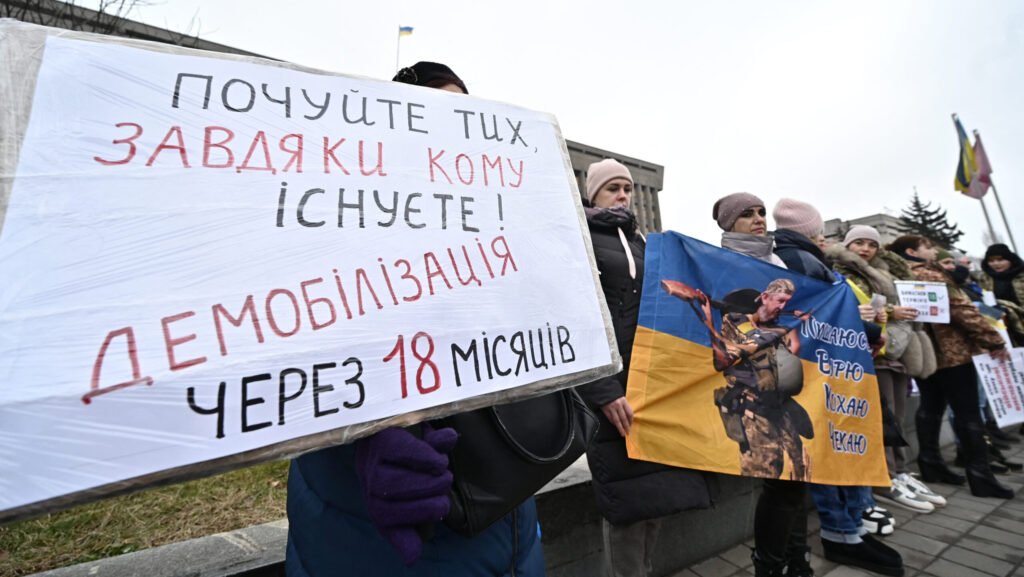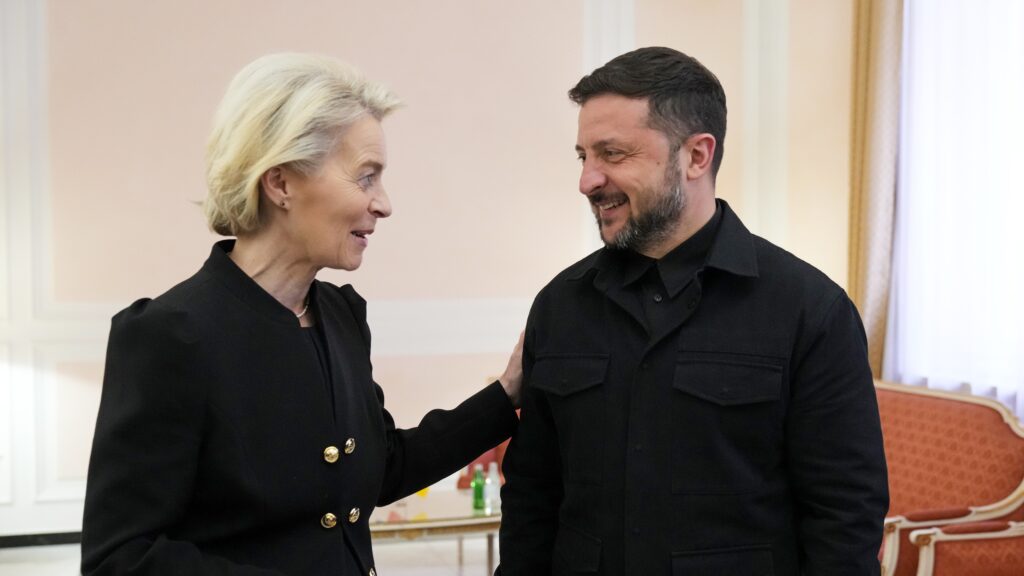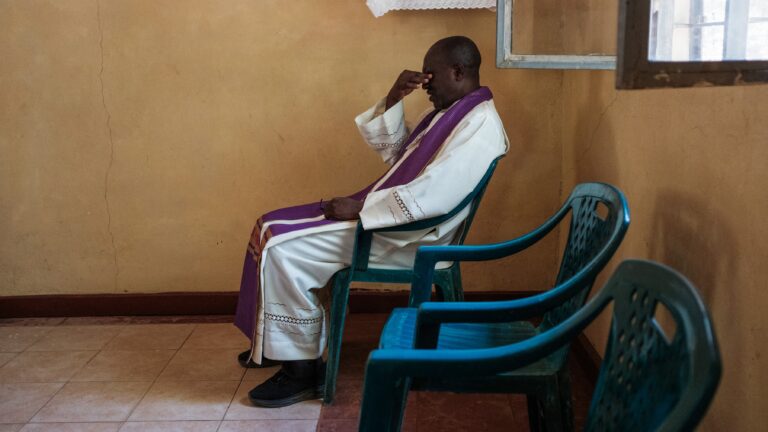In Budapest’s Heroes’ Square, in the Gallery of Hungarian Kings, there is no statue of the tragic King Ladislaus IV (r. 1272–1290), born of a Cuman mother, but at least a relief commemorates the Battle on the Marchfeld, which took place exactly 746 years ago today. The battle’s historical significance may be in doubt today, but it was surprisingly relevant when the statues were erected around 1900 in the Austro–Hungarian Empire. For Hungarian domestic policy, the message of the event was clear:
the Habsburgs owed everything to Hungarian military assistance from the very beginning of their rule.
The author of the most comprehensive Hungarian military history of all time, József Breit of Doberdò, could not control his anger regarding the battle and the ingratitude of posterity, especially of the Germans and Austrians, towards the Hungarians.[1] Although this is rather an exaggeration since it must be acknowledged that King Rudolf of Germany (r. 1273–1291) owed his victory primarily to his perseverance and strategic talent, there is no doubt that the Hungarian auxiliaries compensated for the small size of his army and seriously confused the Bohemian King Ottokar II (also known as Otakar, r. 1253–1278). It is highly probable that without the thousands of Hungarian auxiliaries, the German King would not have undertaken the clash at the time and place he did.[2]
Along with the Battle of Mohi in 1241, this battle is one of the best-known Hungarian military events. This is partly due to the fact that the author Ottokar au der Gaal, who died around 1320, dedicates several hundred lines of his 100,000-line rhyming chronicle to the battle, including the Hungarian participation. The imagination of contemporaries and posterity, from the chronicler Simon of Kéza to the playwright Franz Grillparzer, was stirred by the unexpected defeat and cruel death of the Grand King of the age, as Ottokar was known, the ‘Golden King’, and the very fact of how an empire could be lost in a matter of hours.
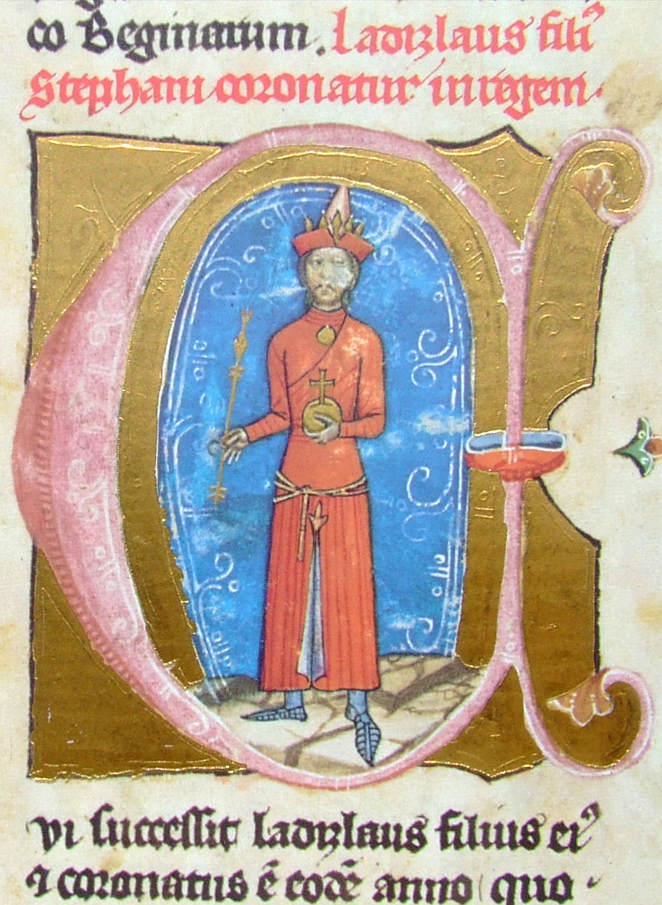
Yet until the weeks leading up to the battle, few doubted Ottokar’s chances of victory. The Bohemian King from the House of Przemysl had been building his empire since 1253. After the death of Emperor Frederick II, he acquired the estates of the extinct Austrian Babenberg Dynasty. He became King of Bohemia in 1253 and then defeated the Hungarian army at the First Battle on the Marchfeld in 1260. In his person, a ruler with a thoroughly Western upbringing and a chivalric culture, he fought for complete power in Central Europe. Fears of ‘Czech domination’ were thus justified in contemporary minds, although this did not mean Slavic at the time, as Prague had by then become the centre of German-language European court poetry. Rudolf was elected King of Germany in 1273, and his ancestral family estates lay in what is now western Switzerland. He, too, was able to increase his properties during the turbulent times following the death of Frederick II, whose power was not recognized only by Ottokar II alone, and whom he contemptuously regarded as a penniless upstart. A clash was thus inevitable.
At the beginning of 1278 the balance of power was in Ottokar’s favour; although Rudolf was the crowned German King, he could hardly count on imperial help. The first to attack in 1278 was the Bohemian King. He set out from Brno on 15 July, but he moved very slowly, never seeking to seize the military initiative. He might well have attempted to retake Vienna by a surprise attack, but instead, he wasted his forces besieging insignificant fortresses.[3]
Rudolf’s most important allies were the Hungarians after he adopted King Ladislaus IV as his son in November 1277.
Little did Ottokar suspect that the Hungarians who joined Rudolf on 23 August were actually preparing his doom.
The battle took place on Friday, 26 August, on the Morava River between Dürnkrut and the Weiden stream.
On 26 August, after the mass and holy communion, the chants of ‘Christ, Christ!’ and opposite them, on the Czechs’ side, the battle cries of ‘Prague, Prague!’ called out. The Hungarians took their places on the left side of the German army, on the first step. It was a surprising but correct decision. The main strength of the Hungarian army was provided by the nomadic Cuman horsemen, who fought very successfully. If the Czechs had underestimated the Cumans, they made a big mistake, as the warring groups of the Cumans very quickly absorbed Western culture. Paradoxically, the most beautiful relics of the Hungarian medieval cavalry culture were found in the cemeteries of the Cumans. In addition to leather armour, their ancestors used chain mails, sometimes even double-edged swords. A horse skeleton found in a Cuman grave proves that one of the finest Arabian war stallions of the time was also used by the Cumans. The Cumans were trained as professional troops in the campaigns of the Hungarian kings to the west in the 1260s. Their peculiar nomadic fighting style successfully disrupted the formation of the opposing Czechs and created the conditions for the Hungarian units fighting in a ‘chivalrous’ manner under the leadership of Máté Csák Trencsényi and his brother István (the uncles of the future king) to crush the opposing wing of Ottokar’s army. The words of the aforementioned Austrian chronicler, who declared the Hungarian leaders to be epic heroes, are particularly significant: ‘I have never heard of the Hungarians, before or since, being so brave in any battle. It is to their great joy that they were chosen and deemed worthy by the King to have the honour of leading the army…They stirred with such agility in battle as if they had only learned the arts of war in France.’[4]
In the final stages of the battle, King Ottokar did not flee, but rode to the front of the line and tried the impossible. His troops, however, were by this time exhausted in the scorching sun, his reserve Polish troops were turning back, and the cry of ‘They are fleeing!’ could be heard louder and louder from Rudolf’s troops. Ottokar’s assassination was told by his descendants in many different ways. The King was easily recognized by his enemies, of which there were many in Rudolf’s camp, by his coat of arms, the silver lion with two tails. If it is true that Ottokar hired knights to assassinate Rudolf in battle, the German King may not have even needed that. The name of his assassin will never be known. According to sources, the King, who bled to death from 17 wounds, was killed by several men with deliberate cruelty, and his corpse was left stripped on the battlefield. While Ottokar’s followers were apparently unperturbed by his excommunication before the battle, his final burial was years in coming. Part of the reason for this was that the long public display of his corpse was intended to prevent rumours of the King’s eventual return. His body was placed in various locations, and it was not until 18 years later, in 1297, that it was allowed to return home to Prague. The Czechs still revere him as one of their greatest kings. In the cathedral of the Prague Castle (Hradčany), he was commissioned by Emperor Charles IV to have a tomb made by the famous sculptor Peter Parler.
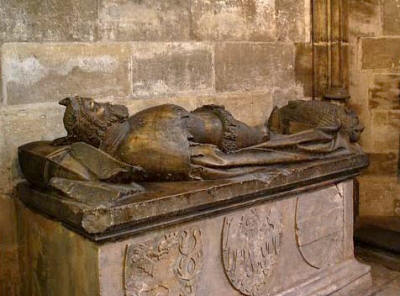
Due to the greed of the looting Hungarians and the Cumans, Rudolf soon sent the Hungarian army home. Of course, he was not stingy with words of praise, as we can read in his letter to King Ladislaus: ‘Language cannot tell, pen cannot describe our infinite joy that you have risen so generously and with such might against our common enemy. For which, praising God, we express to your royal majesty the greatest gratitude we can…’[5]
In the Hungarian historical tradition, it was chronicler Simon of Kéza who created an unparalleled memorial to the battle. Pieces of the loots of war, flags, and shields with coats of arms were a reminder of the victory in Fehérvár (Székesfehérvár today) for a long time, probably until the destruction of the basilica in Fehérvár by the Turks. As recorded by Simon of Kéza: ‘To enshrine the memory of King Ladislas’s singularly glorious and triumphant victory and to the everlasting shame and disgrace of the Czechs, Poles, and Moravians, their shields and banners remain hanging for all time on the wall of the church at Székesfehérvár, the royal seat and throne of Hungary.’[6]
As a result of the Battle on the Marchfeld,
the Czech–Moravian Empire, which had been a constant threat to the Hungarians, fell apart, only to be replaced by an even more powerful Habsburg Empire.
It is true that the throne was not inherited by the Habsburgs after Rudolf’s death, but it was regained again with Hungarian help in 1298. The valour of the Hungarian soldiers was the pledge of the empire from its very birth, and remained so for centuries in its later history, until 1918.
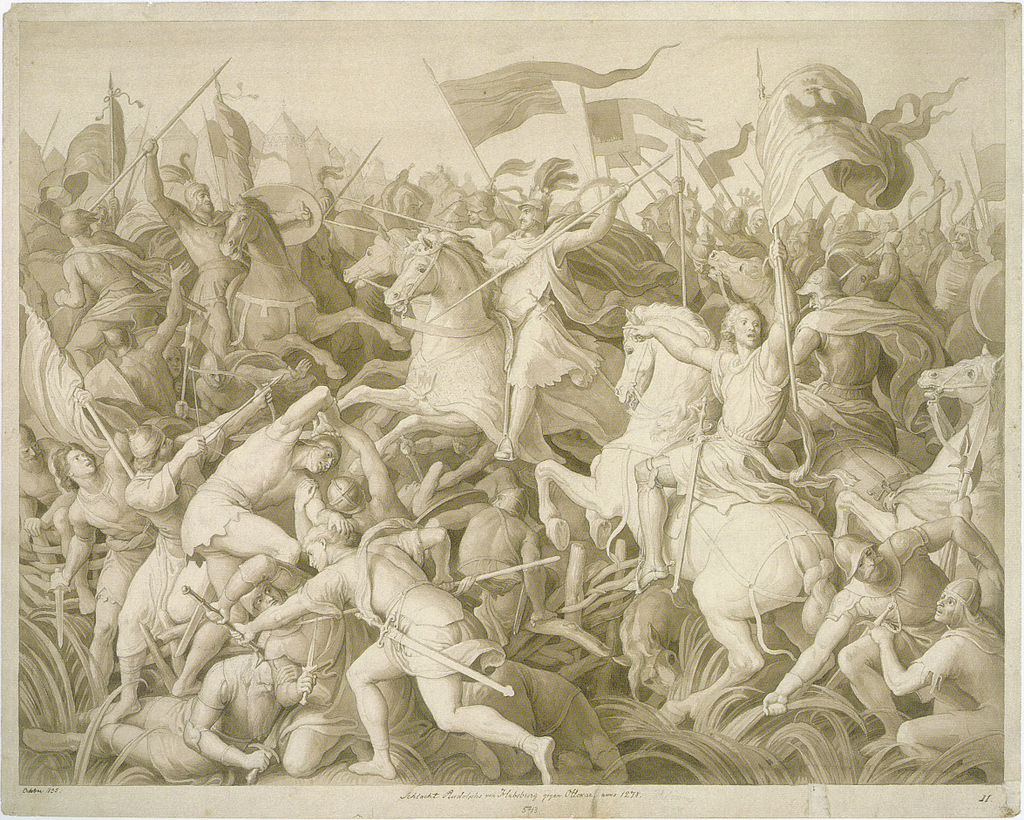
[1] József Breit (Bánlaky), A magyar nemzet hadtörténelme, Vol. 6, Budapest, 1931. (https://www.arcanum.com/hu/online-kiadvanyok/Banlaky-banlaky-jozsef-a-magyar-nemzet-hadtortenelme-2/6-a-tatarjaras-utani-hadjaratok-az-arpadhaz-kihaltaig-12421300-BC6/iii-iv-vagy-kun-laszlo-haborui-D17/2-a-durnkruti-csata-1278-augusztus-26-an-D96/, accessed 5 August 2024.)
[2] Jörg K. Hoensch, Premysl Otakar II. von Böhmen, Der goldene König, Graz–Vienna–Köln, 1989, pp. 245–250.
[3] Martin Clauss, ‘Battle of Dürnkrut’, in Clifford J. Rogers (ed.), The Oxford Encyclopedia of Medieval Warfare and Military Technology, Vol. 1, Oxford, 2010, pp. 552–554.
[4] ‘Monumenta Germaniae Historica Scriptores’, Deutsche Chroniken, Vol. 5, No. 1, Hannover, 1890, p. 215.
[5] Johann Christian Engel, ‘Geschichte des Königreichs Ungarn’, Vol. 1, Vorzeit. Arpadische Könige, Zwischenreich bis 1309, Tübingen, 1811, p. 324.
[6] Simon of Kéza, Gesta Hungarorum/The Deeds of the Hungarians, László Veszprémy and Frank Schaer (ed. and trans.), Budapest, 1999, p. 155.
Related articles:

